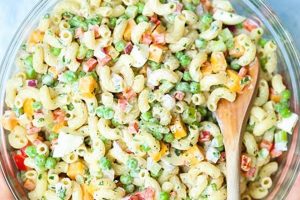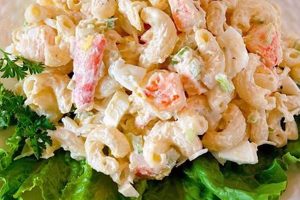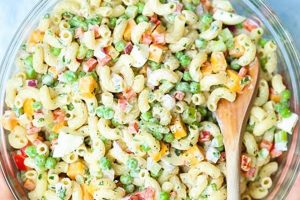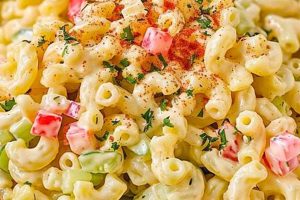A simple macaroni salad typically involves cooked elbow macaroni, mayonnaise, and a few readily available ingredients like celery, onion, and sweet pickle relish. Variations might include hard-boiled eggs, mustard, or different types of vinegar for added flavor. These salads are often characterized by their creamy texture and balanced sweet and savory flavors, making them a popular side dish for picnics, barbecues, and potlucks.
The appeal of a straightforward macaroni salad lies in its convenience and adaptability. Requiring minimal cooking and preparation time, it offers a budget-friendly and satisfying dish. Historically, macaroni salads gained popularity in the mid-20th century as refrigeration became more common, allowing for safe storage of mayonnaise-based dishes. Their versatility allows for customization with various add-ins, catering to diverse palates and dietary preferences. This adaptability contributes to its enduring presence at casual gatherings and everyday meals.
This exploration of simple macaroni salad recipes will cover variations in ingredients, preparation methods, and tips for achieving optimal flavor and texture. Considerations for dietary modifications, such as gluten-free or vegan options, will also be addressed.
Tips for Simple Macaroni Salad Preparation
Achieving a flavorful and well-balanced macaroni salad involves attention to a few key details. The following tips offer guidance for optimal results.
Tip 1: Cook Macaroni Al Dente: Slightly firm macaroni holds its shape better in the salad and prevents a mushy texture. Follow package directions, reducing cooking time by a minute or two for optimal firmness.
Tip 2: Rinse Cooked Macaroni Thoroughly: Rinsing removes excess starch, which can make the salad gummy. Rinse under cold water until the water runs clear.
Tip 3: Drain Macaroni Well: Excess water dilutes the dressing and can lead to a watery salad. Ensure thorough draining before combining with other ingredients.
Tip 4: Use Quality Mayonnaise: Mayonnaise forms the base of the dressing, so using a good quality product enhances the overall flavor.
Tip 5: Balance Sweet and Savory Flavors: Achieve a well-rounded flavor profile by incorporating both sweet and savory elements. Sweet pickle relish, onions, and a touch of sugar or honey provide sweetness, while mustard, vinegar, and celery offer savory notes.
Tip 6: Chill Before Serving: Chilling allows the flavors to meld and enhances the creamy texture. Refrigerate for at least 30 minutes before serving.
Tip 7: Customize with Add-ins: Personalize the salad by incorporating additional ingredients such as hard-boiled eggs, chopped vegetables, or different herbs and spices.
By following these tips, one can create a delicious and satisfying macaroni salad with minimal effort. Proper cooking and draining techniques, combined with a balanced flavor profile and chilling time, contribute significantly to the final result.
These simple guidelines provide a foundation for crafting a classic macaroni salad. The following section will offer variations and adaptations for diverse preferences and dietary needs.
1. Simple Ingredients
The defining characteristic of the easiest macaroni salad recipes lies in the accessibility and limited number of ingredients. This simplicity directly contributes to the ease of preparation, making it an attractive option for quick meals or large gatherings. Recipes emphasizing readily available pantry staplessuch as mayonnaise, celery, onion, and pastaminimize shopping time and effort. This reliance on common ingredients also ensures affordability, making these salads budget-friendly choices. For example, a basic macaroni salad might utilize only cooked macaroni, mayonnaise, celery, onion, sweet pickle relish, salt, and pepper. Such a streamlined ingredient list allows for quick assembly and minimizes the potential for complex flavor imbalances.
The impact of using simple ingredients extends beyond mere convenience. It also allows for greater flexibility in adapting the recipe to individual preferences. Adding a hard-boiled egg, a dash of mustard, or a sprinkle of paprika can subtly shift the flavor profile without demanding additional shopping trips or complicated preparation steps. This adaptability makes simple macaroni salads suitable for diverse palates and dietary restrictions. Consider, for instance, substituting vegan mayonnaise to create a plant-based version, or omitting celery for those with sensitivities. The foundational simplicity accommodates these changes without compromising the fundamental character of the dish.
Ultimately, the emphasis on simple ingredients in macaroni salad recipes serves a practical purpose: to deliver a satisfying and flavorful dish with minimal time and effort. While complex variations certainly exist, the enduring popularity of these simple versions underscores the value of accessibility and ease in everyday cooking. This focus on straightforward ingredients makes macaroni salad a consistently achievable and enjoyable dish for a wide range of cooks and occasions.
2. Minimal Cooking
Minimal cooking is a defining characteristic of the easiest macaroni salad recipes. The reduced cooking time contributes significantly to the overall convenience and speed of preparation, making it a particularly appealing option for time-constrained individuals or those seeking uncomplicated meal solutions. This aspect directly addresses the desire for efficiency in the kitchen without sacrificing flavor or satisfaction.
- Boiling the Macaroni
The primary cooking task in preparing a simple macaroni salad involves boiling the pasta. This straightforward process typically requires only 8-10 minutes, depending on the pasta shape and desired tenderness. Efficiently cooking the macaroni forms the foundation of the recipe’s speed and simplicity. Undercooking or overcooking can significantly impact the final texture of the salad, highlighting the importance of adhering to recommended cooking times.
- Optional Ingredient Cooking
Some variations might include hard-boiled eggs, which necessitate a separate, albeit brief, cooking process. However, even with this addition, the overall cooking time remains relatively short. Other ingredients like celery, onions, and pickles require no cooking at all, further minimizing the time spent over a stove. This minimal cooking approach allows for rapid assembly and emphasizes the freshness of the components.
- Impact on Preparation Time
The limited cooking required for macaroni salad directly translates to a shorter overall preparation time. Once the macaroni is cooked and cooled, combining it with the remaining ingredients takes only a few minutes. This speed and efficiency make it a convenient choice for weeknight meals, potlucks, or any occasion where time is a constraint. The ability to prepare a satisfying dish quickly contributes to its enduring popularity.
- Focus on Freshness and Flavor
The minimal cooking involved in these recipes helps to preserve the fresh flavors and textures of the ingredients. This emphasis on freshness contributes to a vibrant and appealing salad. Because the majority of ingredients are not subjected to heat, they retain their crispness and natural flavors, creating a lighter and more refreshing dish.
The minimal cooking requirement underscores the ease and convenience associated with these types of macaroni salad recipes. This characteristic allows for efficient meal preparation without compromising on flavor or satisfaction. By focusing on simple cooking methods and readily available ingredients, these recipes offer a practical and appealing option for a variety of occasions.
3. Quick Preparation
Quick preparation is a cornerstone of the “easiest macaroni salad recipe” concept. The speed at which these salads can be assembled directly contributes to their appeal, particularly for busy individuals or occasions requiring minimal kitchen time. This characteristic stems from several factors inherent in the recipe’s design: pre-cooked ingredients, simple procedures, and minimal cooking. Pre-cooked ingredients, such as readily available pasta, eliminate the need for extensive preparation. Simple procedures, typically involving combining ingredients in a bowl, streamline the assembly process. Minimal cooking, often limited to boiling the pasta, reduces active cooking time significantly. The combined effect of these elements allows for a completed dish in minutes, a key advantage aligning with the “easiest” classification.
Consider the practical implications of quick preparation. A spontaneous picnic, a last-minute potluck contribution, or a simple weeknight side dish all benefit from the speed and efficiency inherent in these recipes. For instance, a basic macaroni salad requires only cooked pasta, mayonnaise, celery, and onioningredients commonly found in most kitchens. Combining these elements takes mere minutes, making it an ideal solution for unexpected meal demands or limited preparation time. This speed and efficiency are particularly valuable in larger-scale food preparation, such as catering events or family gatherings, where time constraints often necessitate streamlined recipes. The ability to quickly produce a substantial quantity of food without compromising quality contributes significantly to the practical value of these salads.
In conclusion, quick preparation is integral to what constitutes an “easiest macaroni salad recipe.” This attribute, achieved through pre-cooked or readily available ingredients, simple procedures, and minimal cooking, aligns directly with the demand for efficiency in the kitchen. The practical implications of this speed, evident in scenarios ranging from spontaneous meals to large-scale food preparation, solidify the importance of quick preparation as a core component of the “easiest” classification. Recipes designed for rapid assembly empower individuals to create satisfying dishes with minimal time investment, enhancing the accessibility and enjoyment of home-cooked meals.
4. Adaptable Flavors
Adaptability of flavor is a key characteristic of the easiest macaroni salad recipes. This adaptability stems from the simplicity of the base recipe, which readily accommodates a wide range of additions and modifications without requiring complex adjustments or specialized ingredients. The neutral canvas of macaroni, mayonnaise, and basic seasonings allows individual preferences and available ingredients to dictate the final flavor profile. This flexibility ensures the recipe remains accessible and appealing to a diverse range of palates and dietary needs.
The practical implications of adaptable flavors are significant. Consider the scenario of a potluck dinner: a basic macaroni salad can be easily customized to complement the other dishes on offer. A dash of Dijon mustard and some chopped fresh dill might complement a grilled salmon main course, while a sprinkle of smoked paprika and crumbled bacon could pair well with barbecued ribs. This adaptability also extends to accommodating dietary restrictions. Substituting vegan mayonnaise allows for a plant-based version, while gluten-free pasta ensures accessibility for those with gluten sensitivities. These modifications can be implemented without compromising the fundamental simplicity and ease of the recipe. Further flavor adjustments, such as incorporating chopped olives, roasted red peppers, or different herbs, can elevate the salad from a simple side dish to a more complex and flavorful offering.
The connection between adaptable flavors and the “easiest macaroni salad recipe” lies in the recipe’s ability to serve as a template for personalized creations. This inherent flexibility lowers the barrier to entry for novice cooks and provides experienced cooks with a foundation for experimentation. The ease of adaptation ensures that even with limited ingredients or specific dietary requirements, a satisfying and flavorful macaroni salad can be easily achieved. The simplicity of the base recipe, combined with the wide range of potential flavor modifications, solidifies its position as a versatile and accessible culinary staple.
5. Budget-Friendly
Affordability is a significant factor contributing to the enduring popularity of the easiest macaroni salad recipes. The “budget-friendly” nature of these recipes stems from the reliance on inexpensive and readily available ingredients, making them accessible to a wide range of individuals and households. This focus on cost-effectiveness aligns directly with the practical considerations of everyday meal planning, particularly for those seeking economical yet satisfying options. The following facets explore the components, examples, and implications of this budget-friendly characteristic.
- Inexpensive Core Ingredients
Macaroni, mayonnaise, and common vegetables like celery and onions form the foundation of most easy macaroni salad recipes. These staples are typically inexpensive and readily available in most grocery stores, ensuring accessibility regardless of budget constraints. The low cost of these core components allows for frequent preparation without significant financial strain. For instance, dried pasta is a pantry staple known for its affordability and long shelf life, while mayonnaise and basic vegetables are typically budget-friendly options available year-round.
- Flexibility with Add-ins
While basic recipes rely on a limited number of inexpensive ingredients, the adaptable nature of macaroni salad allows for the incorporation of additional components based on individual budgets and preferences. Optional add-ins, such as hard-boiled eggs, relish, or canned tuna, can enhance the flavor and nutritional value without significantly increasing the overall cost. This flexibility allows individuals to customize the salad based on available resources and desired flavor profiles. For example, using leftover cooked chicken or ham can add protein and flavor without requiring the purchase of additional ingredients.
- Stretching Food Budgets
Macaroni salad’s inherent adaptability contributes to its effectiveness in stretching food budgets. Its versatility as a side dish allows it to complement a variety of main courses, from simple grilled meats to more elaborate casseroles. The ability to prepare a substantial quantity for a relatively low cost makes it a valuable asset in feeding families or groups on a budget. Furthermore, leftover macaroni salad can be repurposed in other dishes, such as sandwiches or wraps, further maximizing its value and minimizing food waste.
- Cost-Effective Meal Solution
The combination of low-cost ingredients, adaptability, and satisfying nature positions macaroni salad as a cost-effective meal solution. It offers a balanced combination of carbohydrates, fats, and (depending on the add-ins) protein, providing a filling and nutritious meal component without requiring expensive ingredients or elaborate preparation techniques. This makes it an attractive option for individuals and families seeking economical and convenient meal choices.
The budget-friendly nature of the easiest macaroni salad recipes is a key factor contributing to their widespread appeal. The reliance on affordable staples, flexibility with add-ins, and ability to stretch food budgets makes these salads a practical and economical choice for a wide range of individuals and households. The combination of affordability, ease of preparation, and satisfying flavors ensures that macaroni salad remains a popular and accessible dish for various occasions and budgets.
Frequently Asked Questions
This section addresses common inquiries regarding the preparation and variations of simple macaroni salad recipes.
Question 1: What type of pasta is best suited for macaroni salad?
Elbow macaroni is the traditional choice due to its shape, which holds the dressing well. However, other small pasta shapes like shells, rotini, or ditalini can also be used.
Question 2: How can one prevent macaroni salad from becoming watery?
Thoroughly draining the cooked macaroni and ensuring all vegetables are dry before combining with the dressing are crucial steps. Over-dressing can also contribute to a watery consistency, so it’s best to start with a smaller amount of dressing and add more as needed.
Question 3: Can macaroni salad be made ahead of time?
Yes, macaroni salad can be made a day or two in advance. Store it in an airtight container in the refrigerator. The flavors often meld and improve with time.
Question 4: What are some suitable variations for vegetarian or vegan macaroni salads?
Substituting vegan mayonnaise and omitting hard-boiled eggs creates a vegan version. Adding other vegetables, such as chopped bell peppers, cucumbers, or chickpeas, can enhance flavor and texture.
Question 5: How can one adjust the sweetness or tanginess of the dressing?
A touch of sugar or honey can increase sweetness, while additional vinegar or a squeeze of lemon juice can enhance tanginess. Adjusting these elements to taste allows for personalized flavor preferences.
Question 6: How long does macaroni salad typically last in the refrigerator?
Macaroni salad typically lasts for 3-5 days when stored properly in an airtight container in the refrigerator. However, it’s crucial to observe any signs of spoilage, such as off-odors or changes in texture, before consumption.
Understanding these common points of inquiry aids in successful macaroni salad preparation and facilitates customization based on individual preferences and dietary needs. Thorough preparation, proper storage, and thoughtful ingredient selection contribute significantly to a satisfying culinary experience.
The following section will provide specific recipe examples showcasing the variety and adaptability of simple macaroni salads.
Easiest Macaroni Salad Recipe
Exploration of the “easiest macaroni salad recipe” reveals the enduring appeal of simplicity and adaptability in cooking. Minimal cooking requirements, readily available ingredients, and quick preparation times contribute to its practicality for both everyday meals and larger gatherings. The inherent adaptability of the basic recipe allows for a wide range of flavor modifications, accommodating diverse palates and dietary needs. From classic combinations to innovative variations, the core principles of ease and affordability remain central to its enduring popularity.
The accessibility of the “easiest macaroni salad recipe” empowers individuals to create satisfying and personalized dishes with minimal effort. Its adaptability ensures continued relevance in evolving culinary landscapes, highlighting the enduring value of simple, budget-friendly, and delicious food. This foundational recipe provides a versatile springboard for culinary creativity, encouraging exploration and enjoyment within the realm of home cooking.






